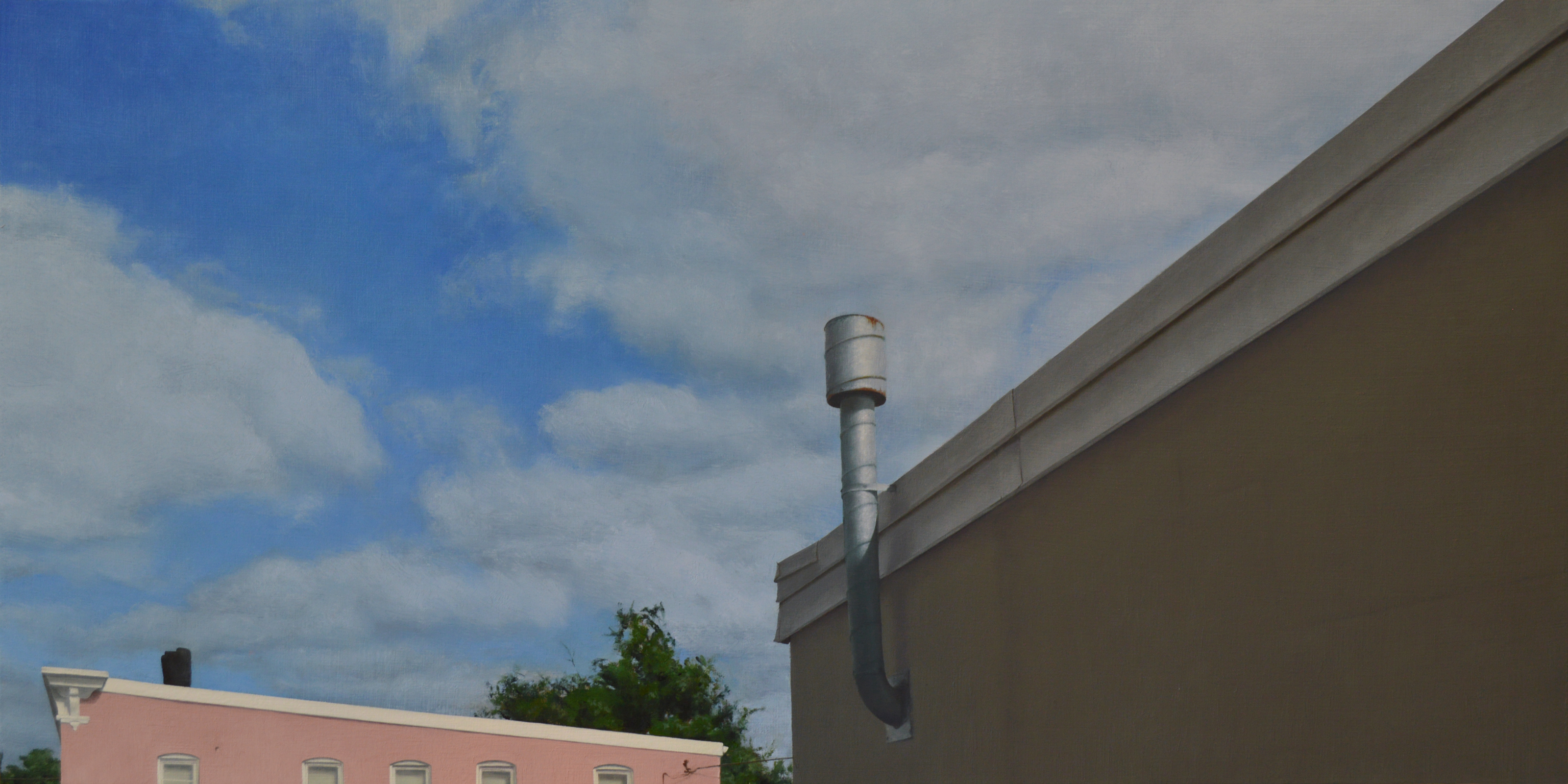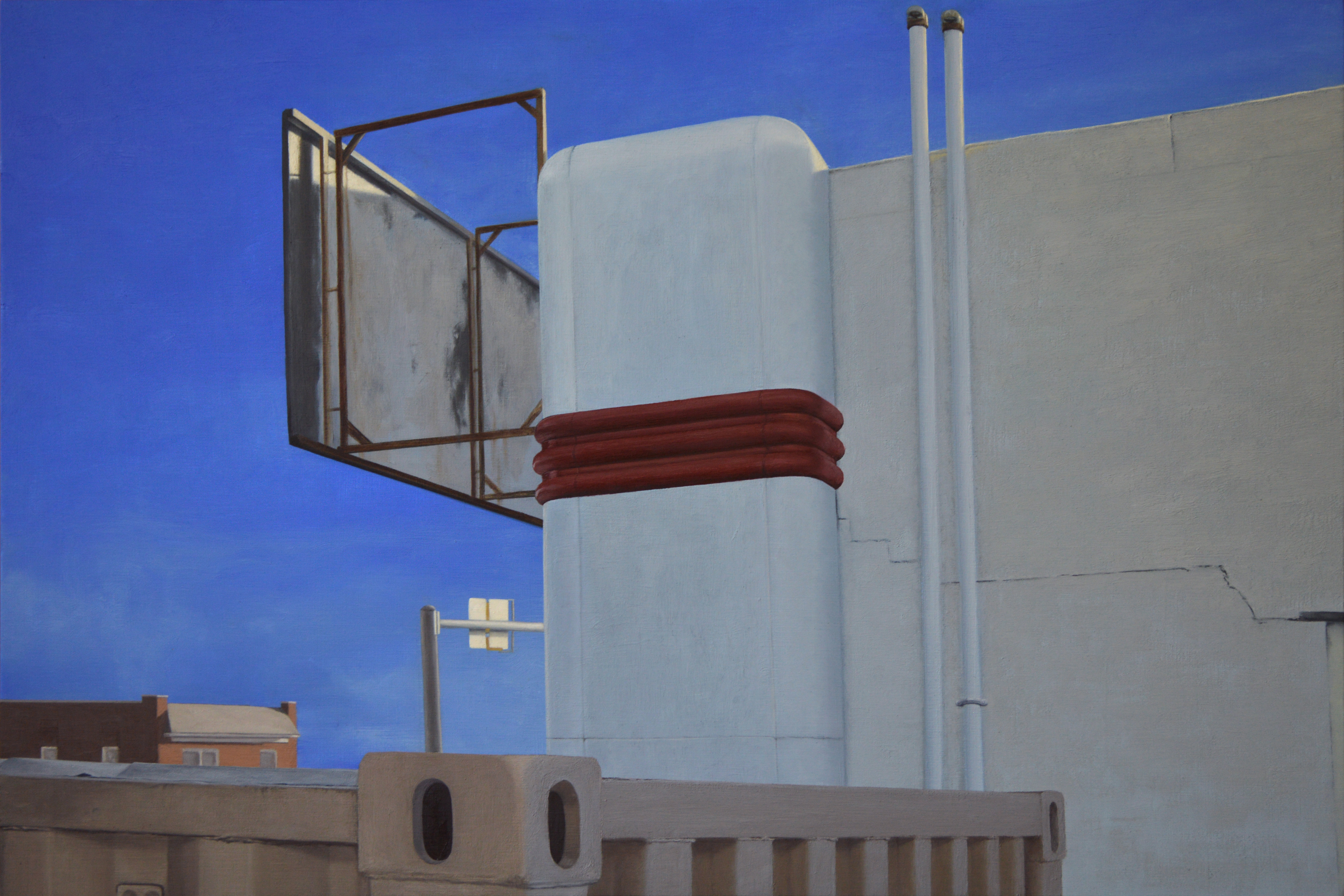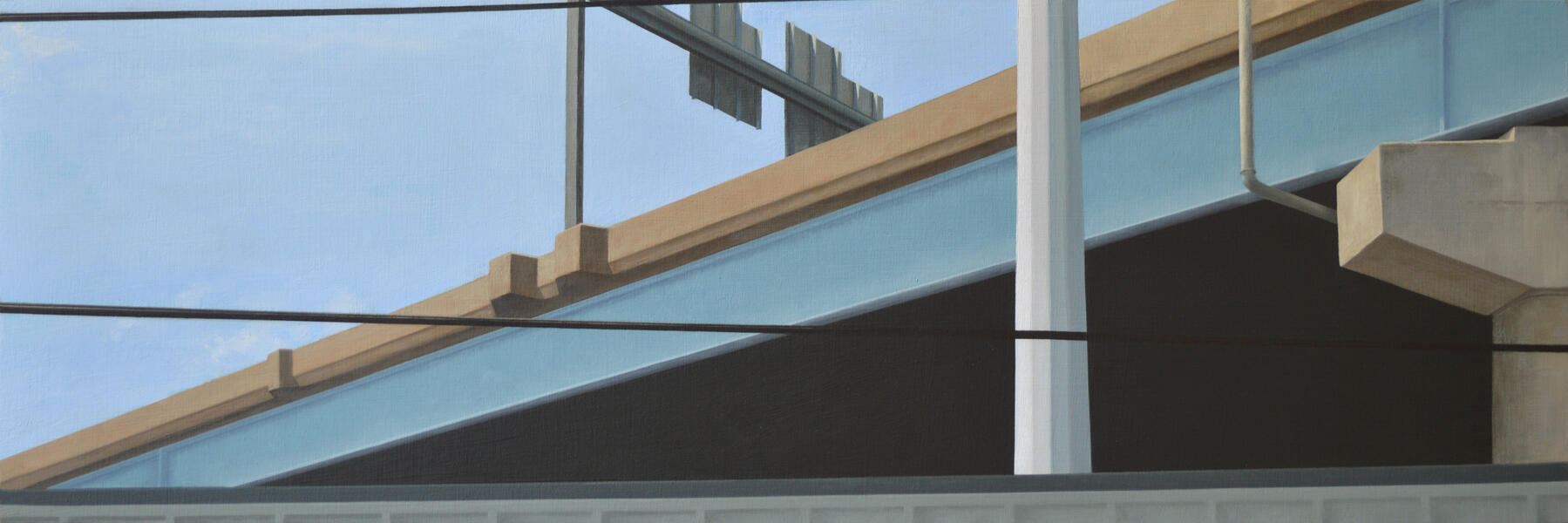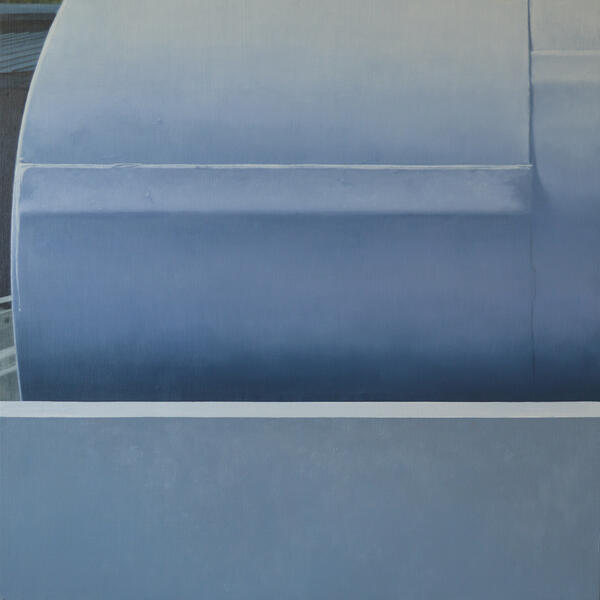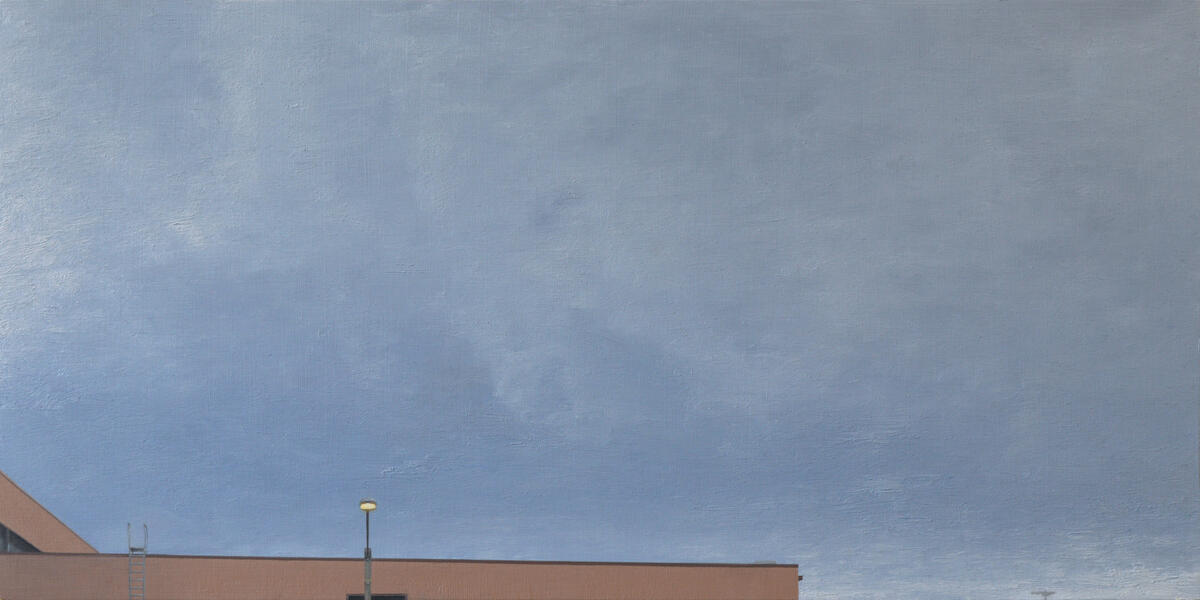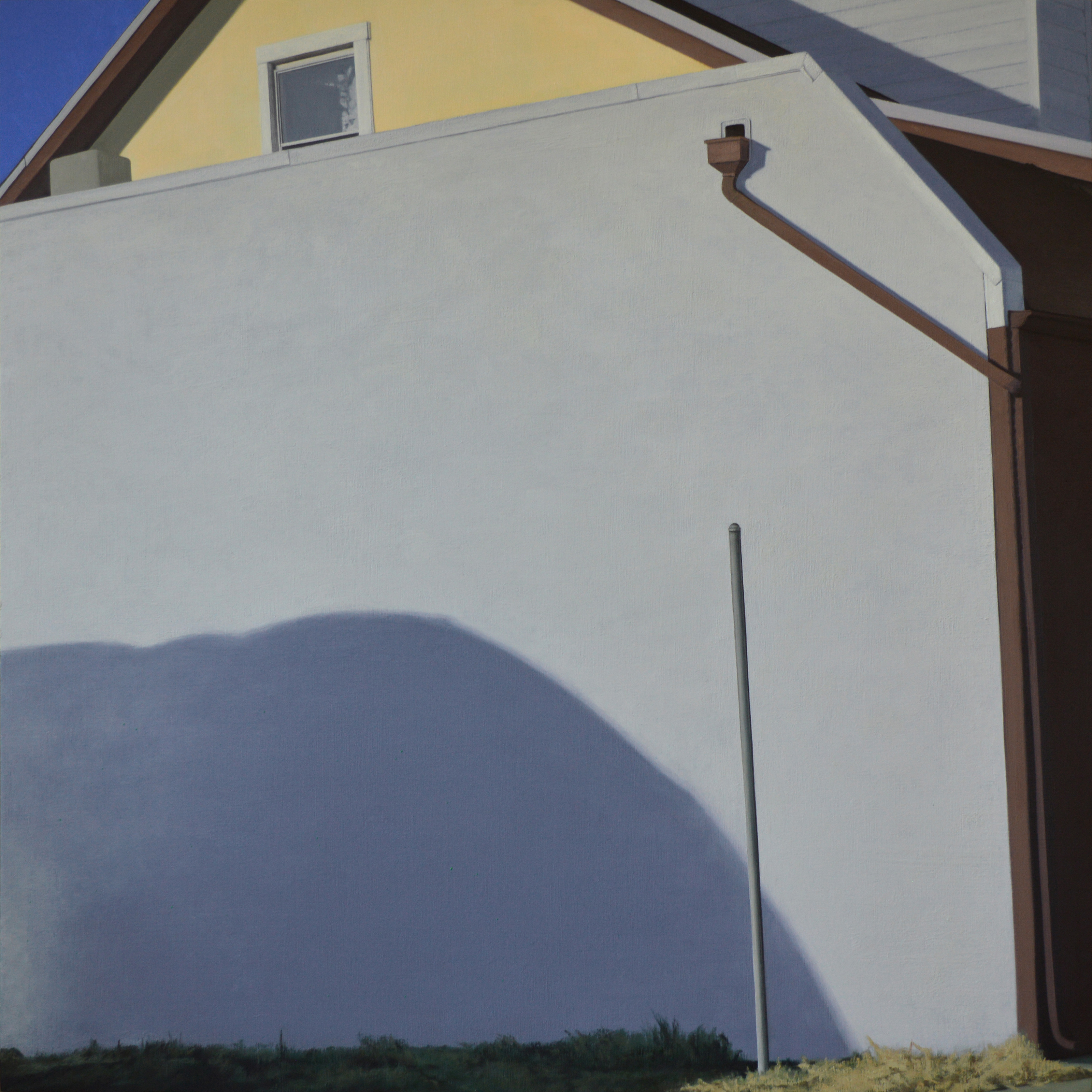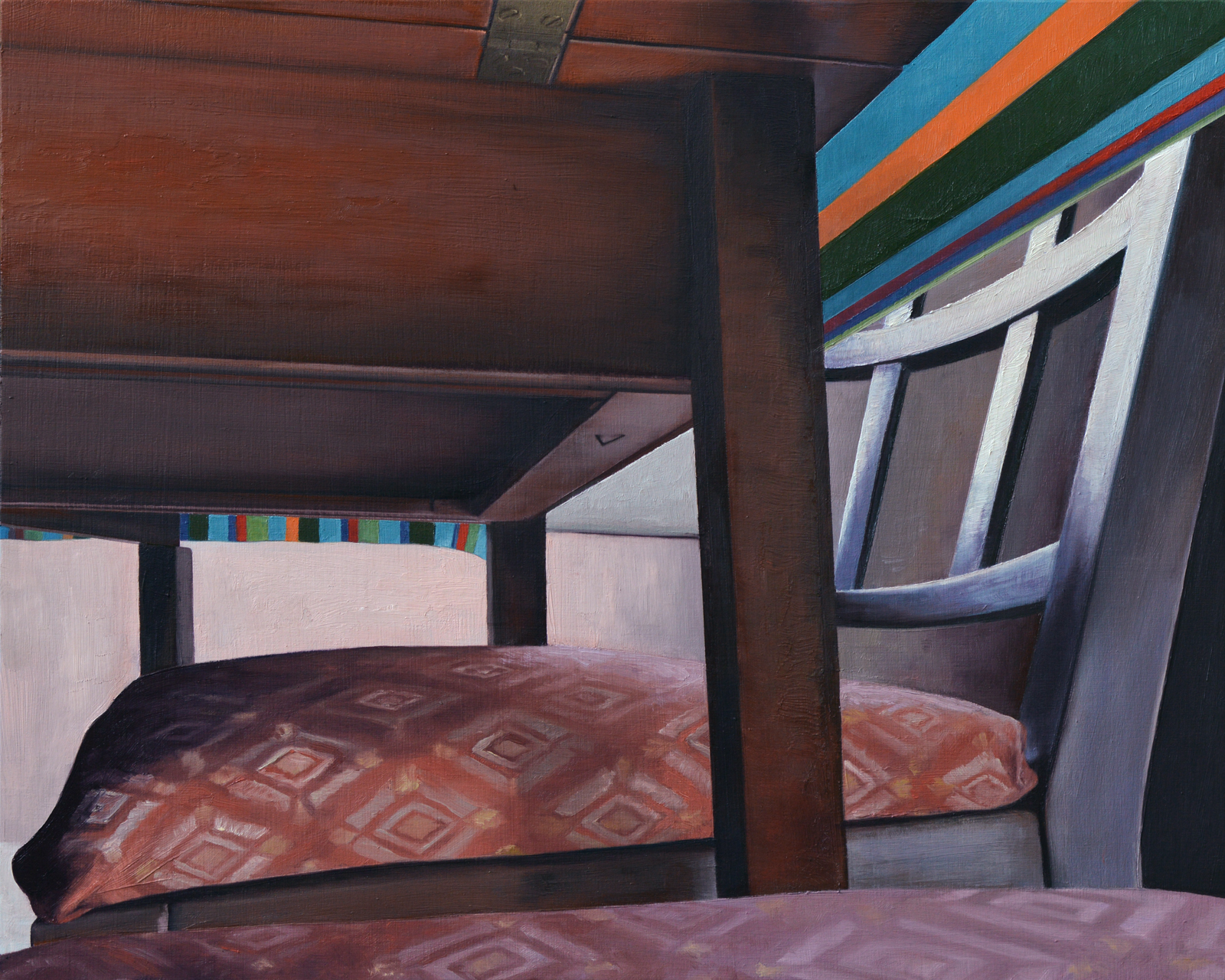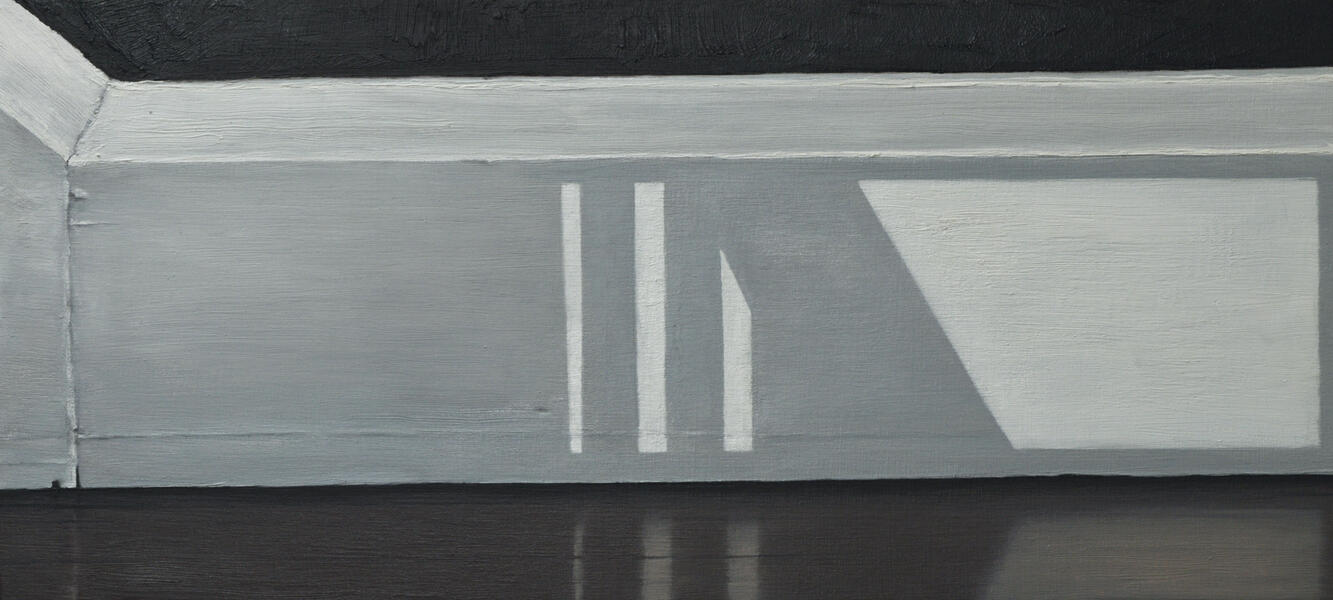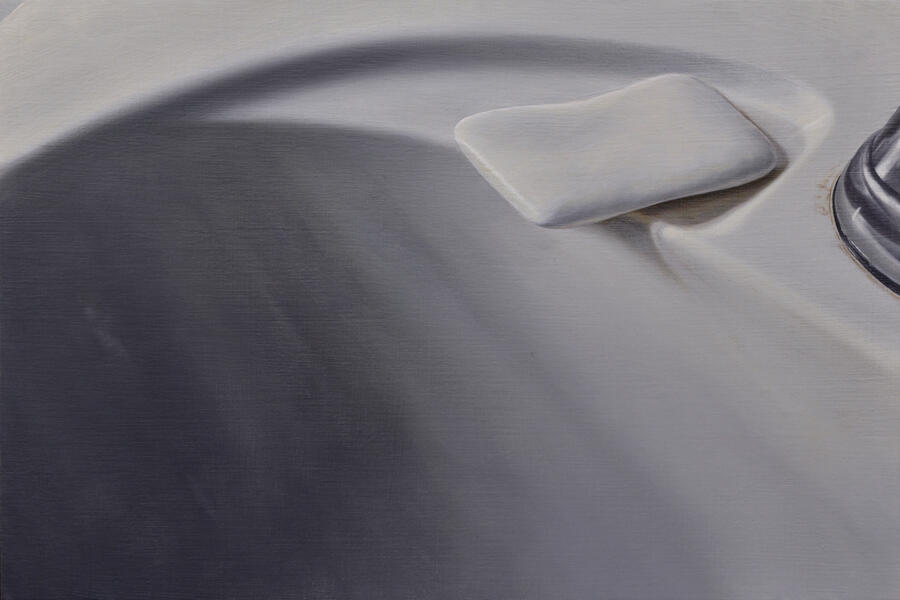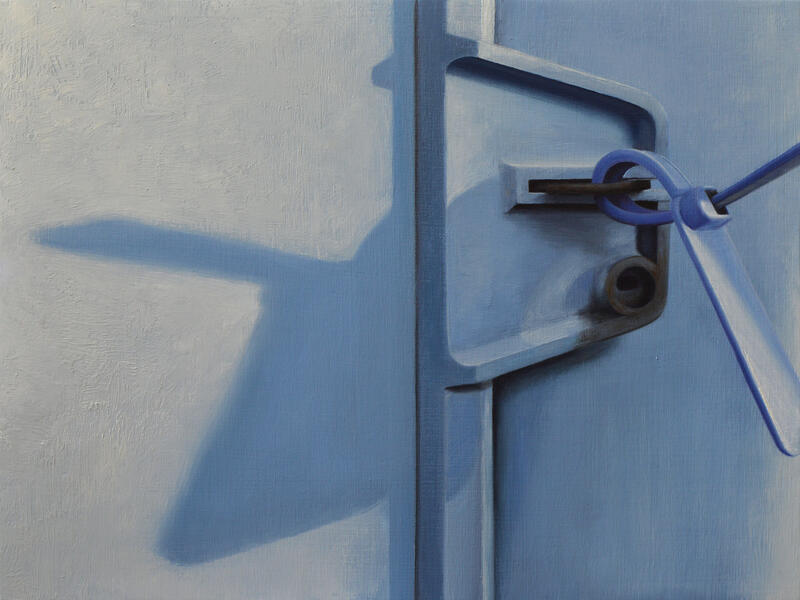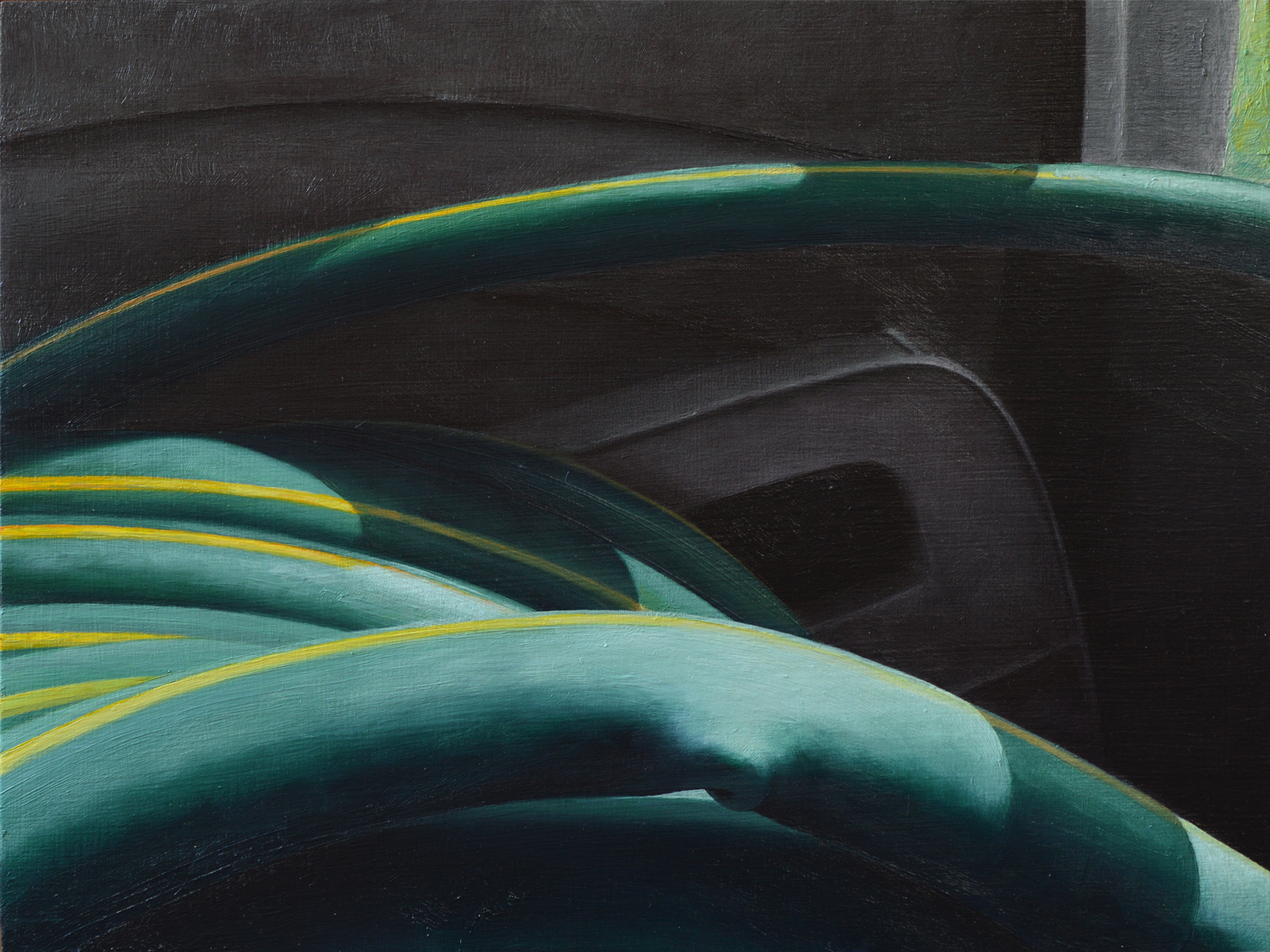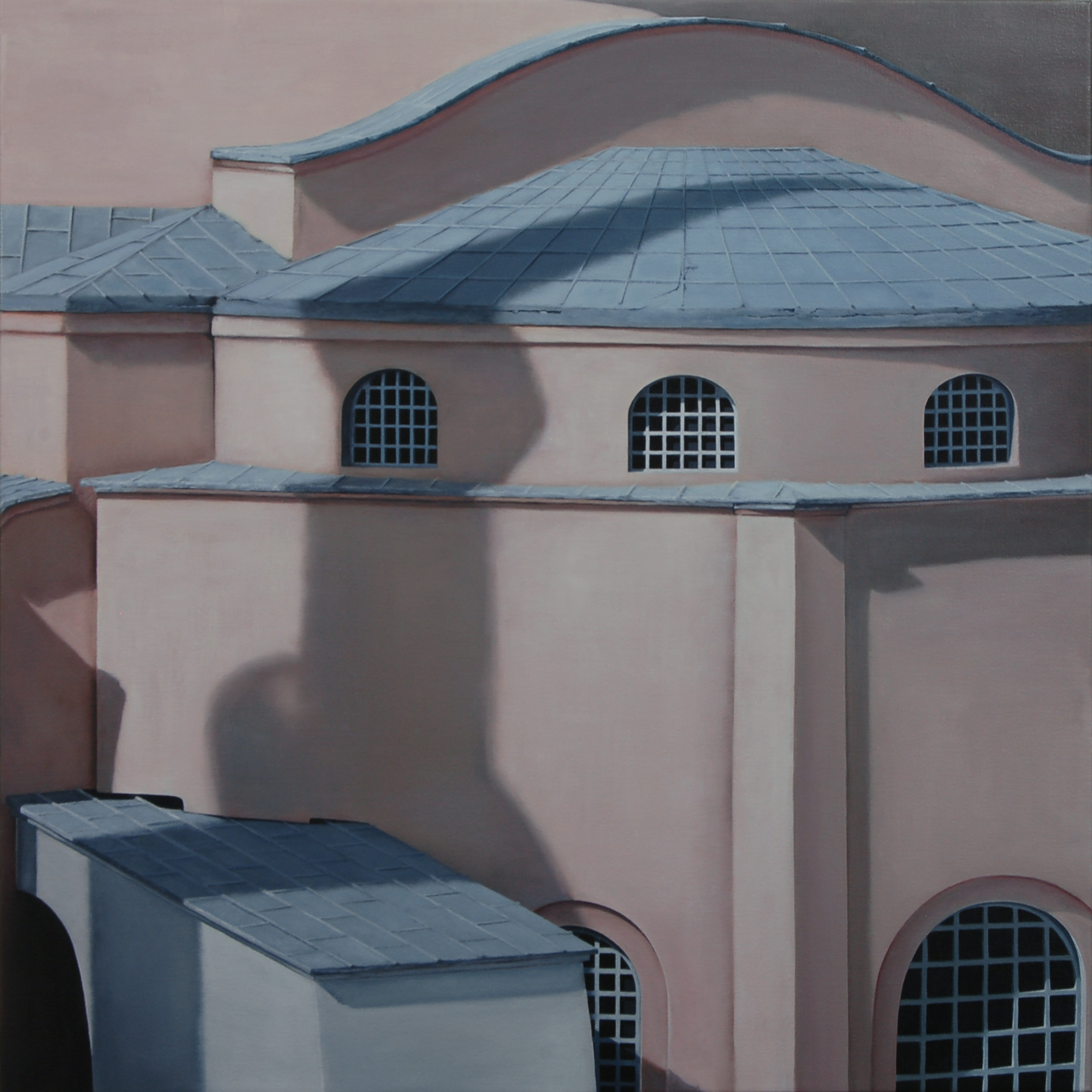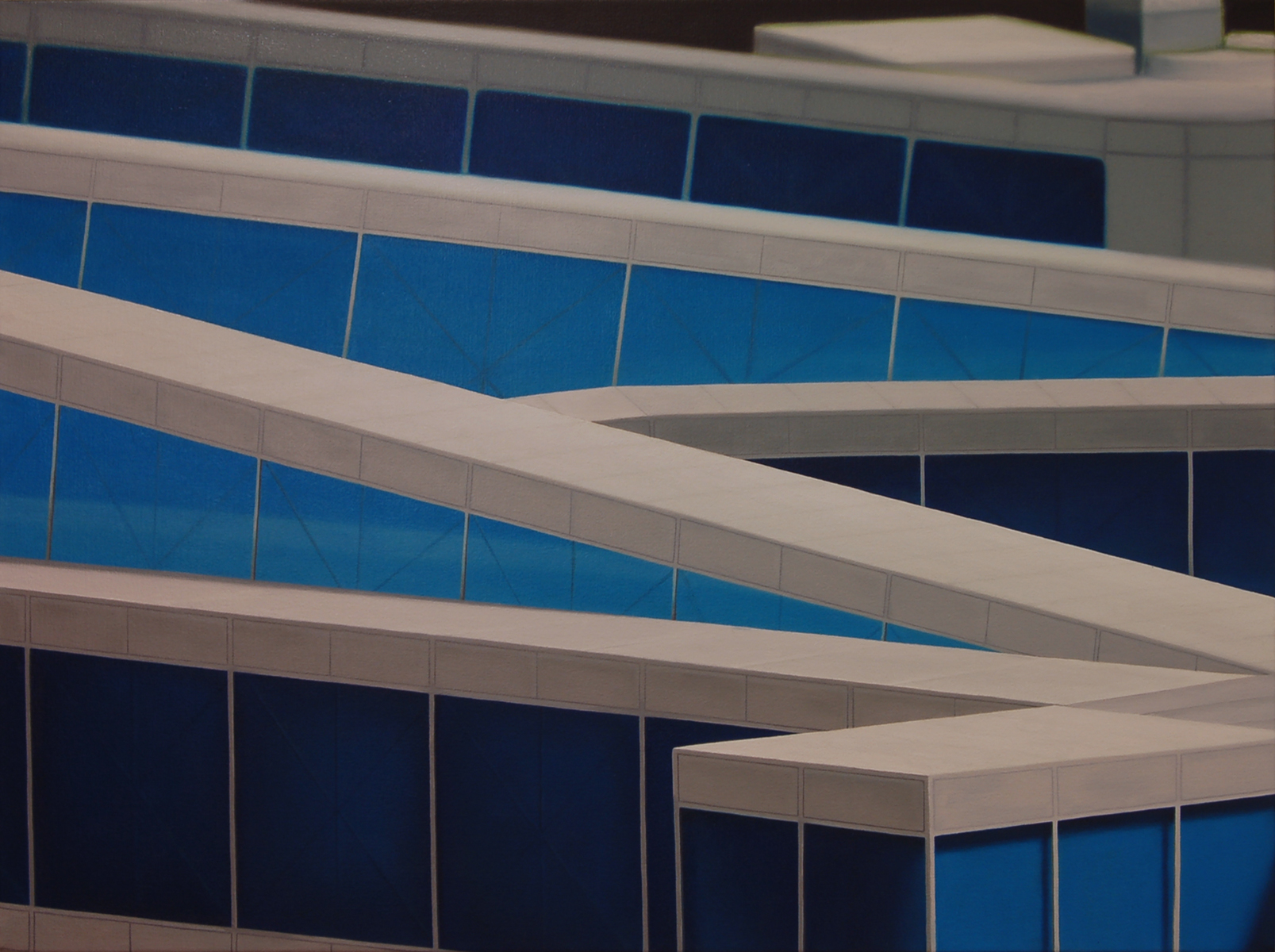About Lillian Bayley
Baltimore City

Lillian Hoover earned her BFA from the University of North Carolina, Asheville and her MFA from Maryland Institute College of Art. Her paintings are included in several public collections including the Baltimore Museum of Art, the Weatherspoon Art Museum, and the DC Commission on Arts and Humanities. In 2020, Hoover received a Pollock-Krasner Grant. Other honors include the Bethesda Urban Partnership’s Trawick Award, multiple Individual Artist Awards from Maryland State… more
Jump to a project:
Borders
These paintings continue to become simpler, quieter, more still, somewhat uneasy, always invested in the changing conditions of light. I am constantly delighted by the banal visual elements of specific life circumstances, which so often become more compelling than one might expect. In this spirit—as ordinary, imperfect materials are momentarily engaged in awkwardly arresting formal relationships—issues of abstraction continue to be present in these paintings. The liminal spaces I’ve chosen to explore here are comprised of patterns, textures, shapes, and shadows that appear to have arranged themselves with care, awaiting the viewer’s notice.
The subject matter in this series derives from encounters with my neighborhood while taking regular meditation walks, during which I observe the world. The paintings become a record of the daily forms with which I live. I've long felt that things become valuable to us as a result of the attention we pay to them; in some way, attention translates into appreciation. Consequently, the following observation by Frederick Franck resonated with me deeply when I came across it recently: "I have learnt that what I have not drawn, I have never really seen, and that when I start to draw an ordinary thing, I realize how extraordinary it is."
In my neighborhood, the border between a commercial storage space or industrial building and residential lot is permeable: side-by-side, these structures don't belong wholly to one world or the other. This work focuses on the awkward spaces that develop as a result. These paintings also depict many literal barriers: walls, fences, oscillated strand board, bridges, industrial doorways. I'm interested in what happens at the interface between public and private, between a space to which we are granted access and a space to which we are not granted access.
Geometry infuses these paintings, and to some extent I envision this geometry as evidence of human endeavor—so often overruled or undermined by the passing of time and the inevitability of subsequent actions and events. Fascinating irregularities of form and inconsistencies of logic thus emerge.
As in previous work, I continue to be drawn to very banal and awkward subject matter—none of these places is special. What interests me is the way in which something becomes special through sustained attention. In these forgettable, unprepossessing details, I find quietude. The quietude that accompanies these empty places and "wrong" bits isn't insecure, fearful, or nostalgic. Rather than an indictment, the acknowledgement of these awkward moments becomes about present-ness and the joy of looking. This quietude is comfortable with awkwardness, appreciative and mindful of the fleeting moment. These paintings aren’t hopeful, nor waiting or longing. While these spaces do wear their history, they don’t ruminate over what was or look forward to the future, but instead murmur “this is what is.”
The subject matter in this series derives from encounters with my neighborhood while taking regular meditation walks, during which I observe the world. The paintings become a record of the daily forms with which I live. I've long felt that things become valuable to us as a result of the attention we pay to them; in some way, attention translates into appreciation. Consequently, the following observation by Frederick Franck resonated with me deeply when I came across it recently: "I have learnt that what I have not drawn, I have never really seen, and that when I start to draw an ordinary thing, I realize how extraordinary it is."
In my neighborhood, the border between a commercial storage space or industrial building and residential lot is permeable: side-by-side, these structures don't belong wholly to one world or the other. This work focuses on the awkward spaces that develop as a result. These paintings also depict many literal barriers: walls, fences, oscillated strand board, bridges, industrial doorways. I'm interested in what happens at the interface between public and private, between a space to which we are granted access and a space to which we are not granted access.
Geometry infuses these paintings, and to some extent I envision this geometry as evidence of human endeavor—so often overruled or undermined by the passing of time and the inevitability of subsequent actions and events. Fascinating irregularities of form and inconsistencies of logic thus emerge.
As in previous work, I continue to be drawn to very banal and awkward subject matter—none of these places is special. What interests me is the way in which something becomes special through sustained attention. In these forgettable, unprepossessing details, I find quietude. The quietude that accompanies these empty places and "wrong" bits isn't insecure, fearful, or nostalgic. Rather than an indictment, the acknowledgement of these awkward moments becomes about present-ness and the joy of looking. This quietude is comfortable with awkwardness, appreciative and mindful of the fleeting moment. These paintings aren’t hopeful, nor waiting or longing. While these spaces do wear their history, they don’t ruminate over what was or look forward to the future, but instead murmur “this is what is.”
-
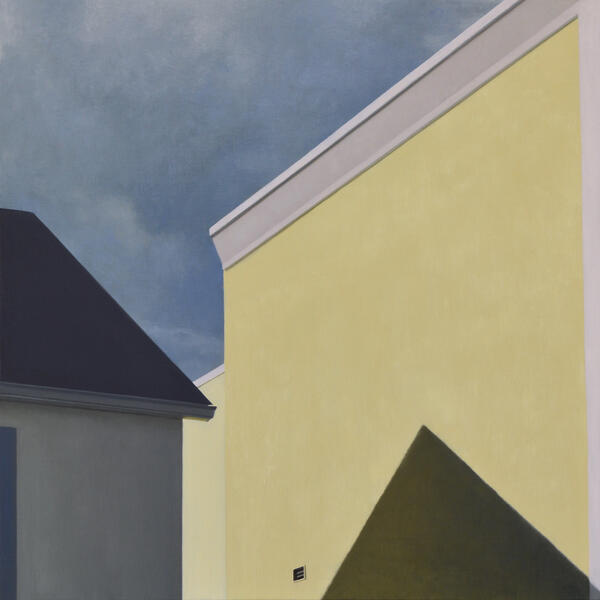 Yellow Warehouse24" x 24" 2015 Oil on Panel
Yellow Warehouse24" x 24" 2015 Oil on Panel -
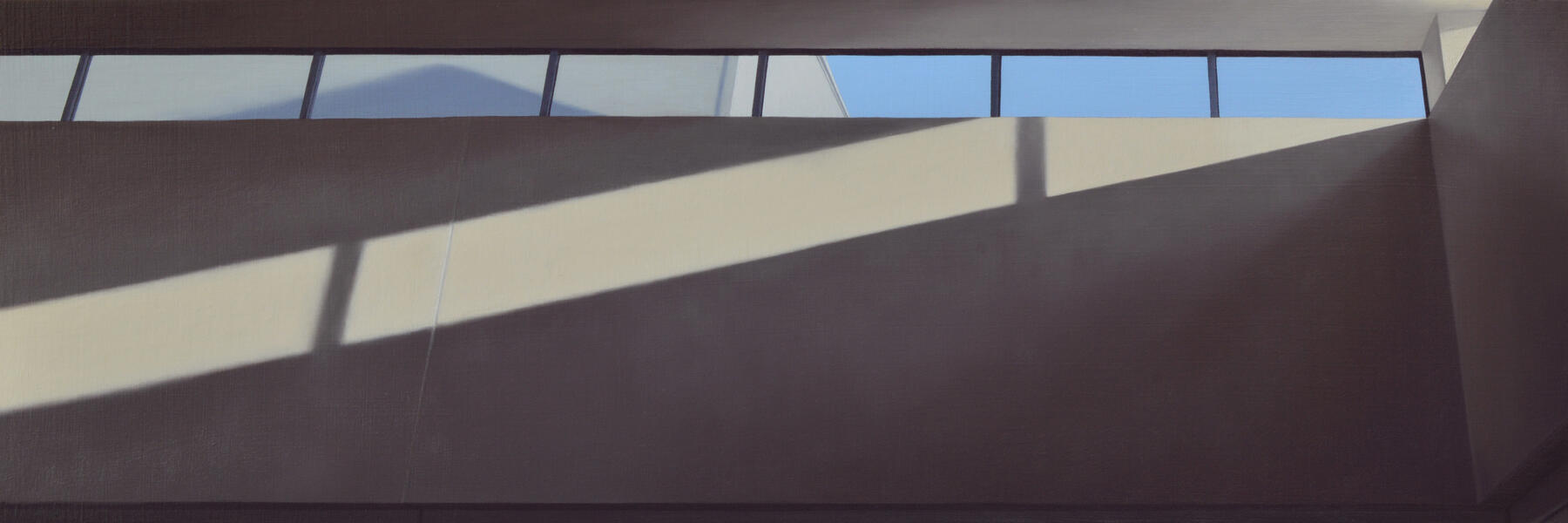 Clerestory12" x 36" 2015 Oil on Panel
Clerestory12" x 36" 2015 Oil on Panel -
 Firehouse18" x 36" 2015 Oil on Panel
Firehouse18" x 36" 2015 Oil on Panel -
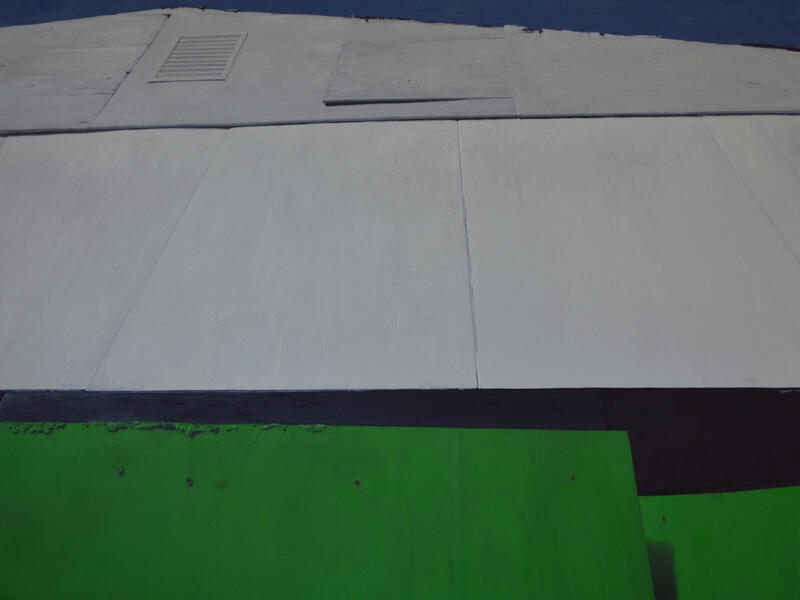 Farmer's Market30” x 40” 2014 Oil on Panel
Farmer's Market30” x 40” 2014 Oil on Panel -
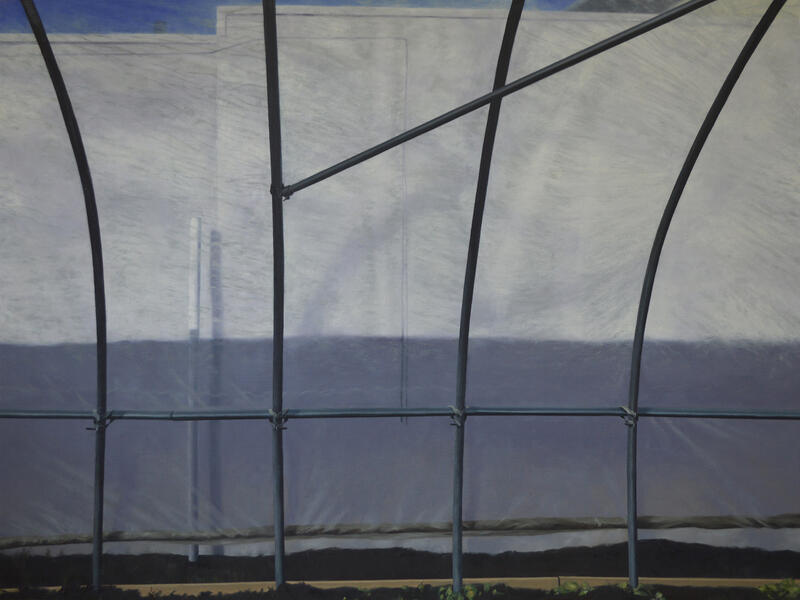 Hoop House36” x 48” 2014 Oil on Panel
Hoop House36” x 48” 2014 Oil on Panel -
 Storage Pod24” x 36” 2014 Oil on Panel
Storage Pod24” x 36” 2014 Oil on Panel -
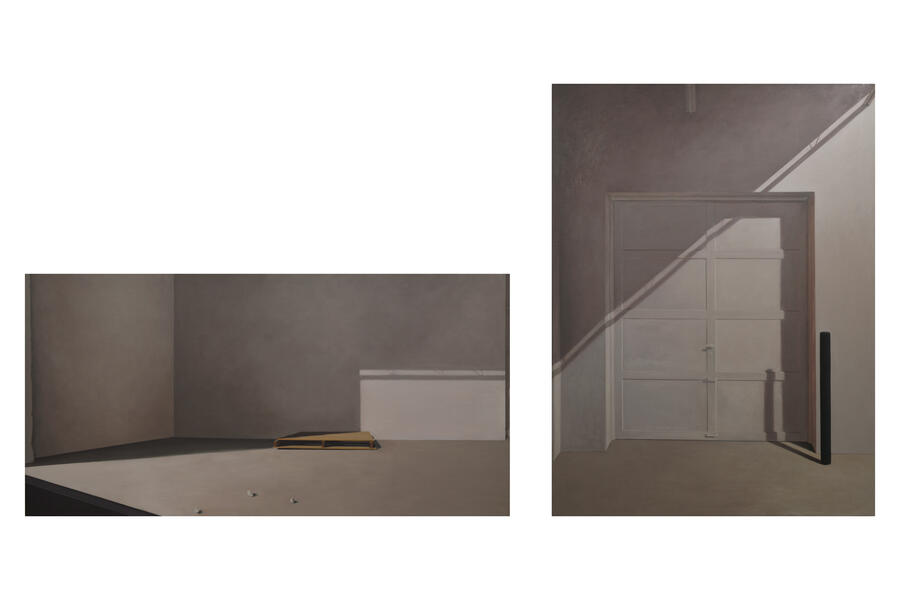 Loading Dock100” x 54” 2013 Oil on Panel
Loading Dock100” x 54” 2013 Oil on Panel -
 Ladder24” x 48” 2014 Oil on Panel
Ladder24” x 48” 2014 Oil on Panel -
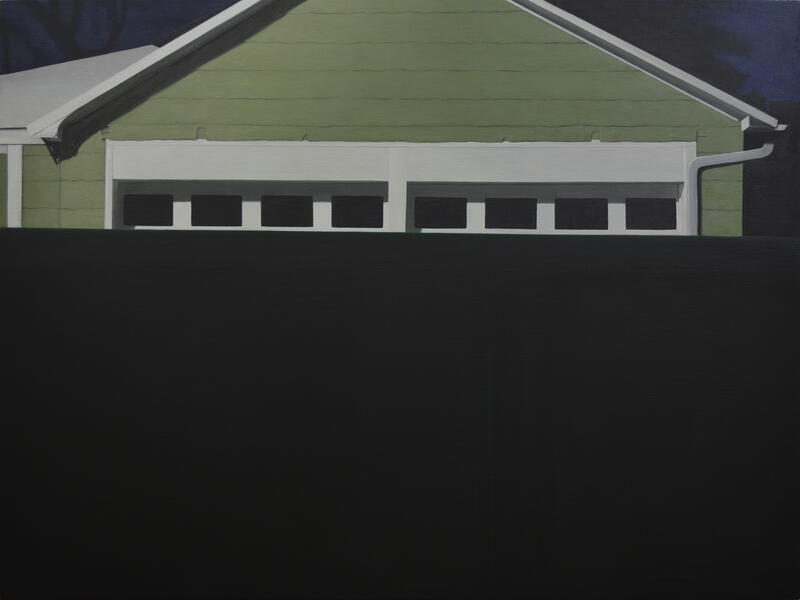 Dumpster30” x 40” 2013 Oil on Panel
Dumpster30” x 40” 2013 Oil on Panel -
 Bridge18” x 48” 2013 Oil on Panel
Bridge18” x 48” 2013 Oil on Panel
As It Is
An outgrowth of previous examinations of disintegrating architectural models, the focus of this series continues to be on awkward interruptions of what might typically be considered the "right" picture. Each painting represents a single brief moment in which routine artifacts of one’s daily life are illuminated and transformed, activated by the momentary attention. Banal, domestic flaws—features that are typically avoided in the course of self-representation—are here given center stage. These stained, chipped, misaligned, and untidy items are intensely personal, but the paintings aren’t of a confessional nature. Instead, the tableaus explore the delight of discovery as ordinary, imperfect materials are momentarily engaged in awkwardly arresting formal relationships. My interest in the unstable line between abstraction and representation remains a prominent thread in this work.
Each of these images are clearly informed by photography’s ability to “fix” a moment in time and by the logic of selection that accompanies the era of digital manipulation. Nevertheless, these works embrace the language of painting more completely than previous series did. Photography is no longer deployed as a distancing or filtering mechanism, the emphasis on photographic depth of field is eliminated, and the paintings’ surfaces are of a tactile nature. Both the artist’s hand and the viscosity of paint have become more active participants in the work. And while the use of photography and cropping remain central to this process, the character of my photographic sources has changed. No longer "trophies" or souvenirs of the spectacle of power—and tourism—the images and moments are definitively mine, embracing the incidental and insignificant facets of my personal environment.
Each of these images are clearly informed by photography’s ability to “fix” a moment in time and by the logic of selection that accompanies the era of digital manipulation. Nevertheless, these works embrace the language of painting more completely than previous series did. Photography is no longer deployed as a distancing or filtering mechanism, the emphasis on photographic depth of field is eliminated, and the paintings’ surfaces are of a tactile nature. Both the artist’s hand and the viscosity of paint have become more active participants in the work. And while the use of photography and cropping remain central to this process, the character of my photographic sources has changed. No longer "trophies" or souvenirs of the spectacle of power—and tourism—the images and moments are definitively mine, embracing the incidental and insignificant facets of my personal environment.
-
 untitled (cooler)18" x 12" 2012 Oil on Panel
untitled (cooler)18" x 12" 2012 Oil on Panel -
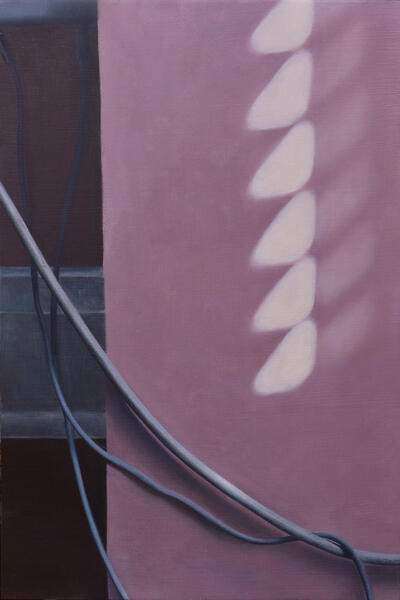 untitled (cords)18" x 12" 2012 Oil on Panel
untitled (cords)18" x 12" 2012 Oil on Panel -
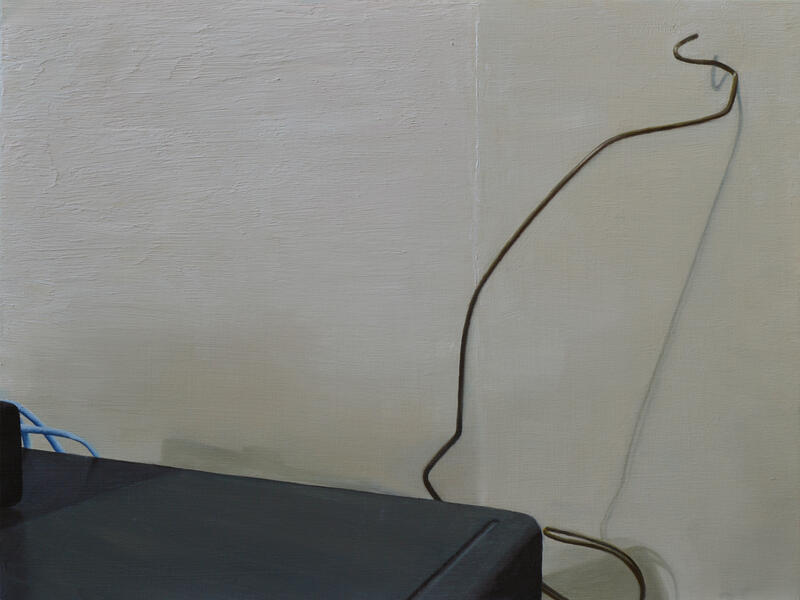 untitled (coat hanger and router)12" x 16" 2013 Oil on Panel
untitled (coat hanger and router)12" x 16" 2013 Oil on Panel -
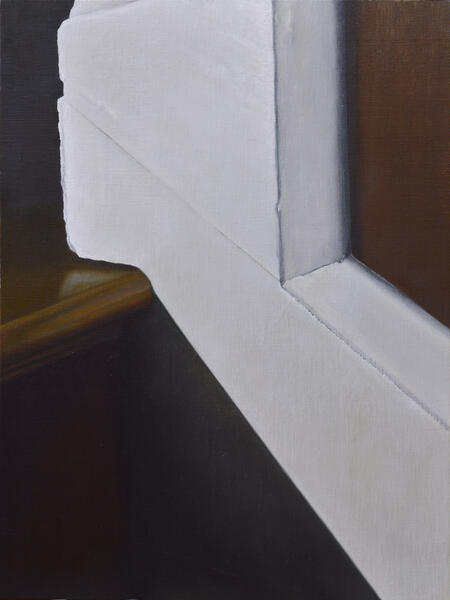 untitled (stairs and molding)16" x 12" 2013 Oil on Panel
untitled (stairs and molding)16" x 12" 2013 Oil on Panel -
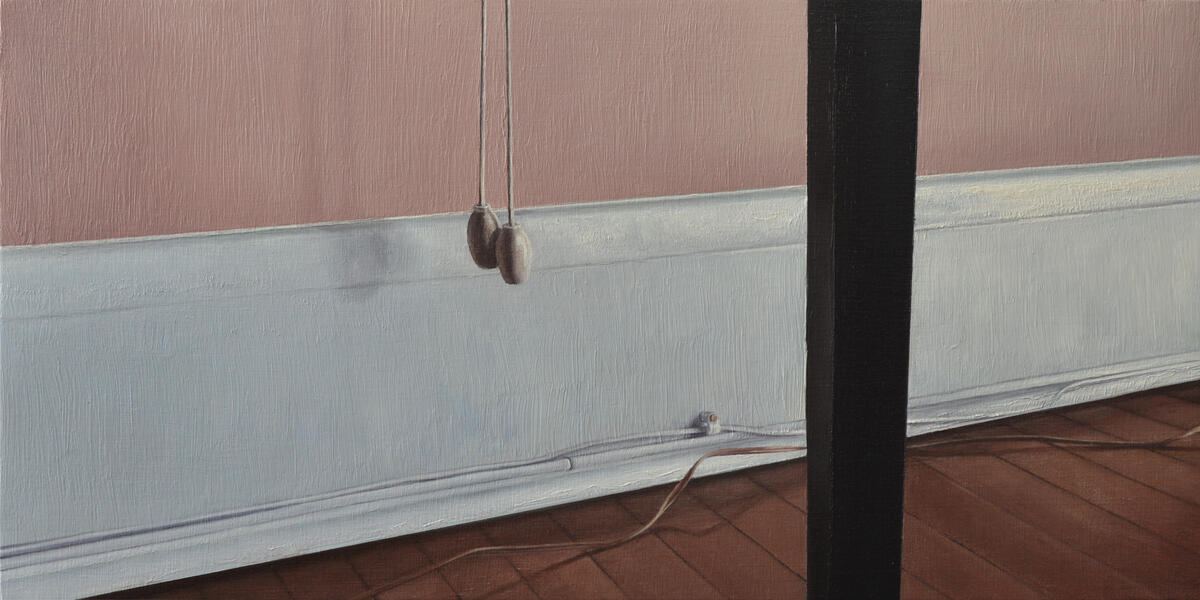 untitled (baseboard)12" x 24" 2013 Oil on Panel
untitled (baseboard)12" x 24" 2013 Oil on Panel -
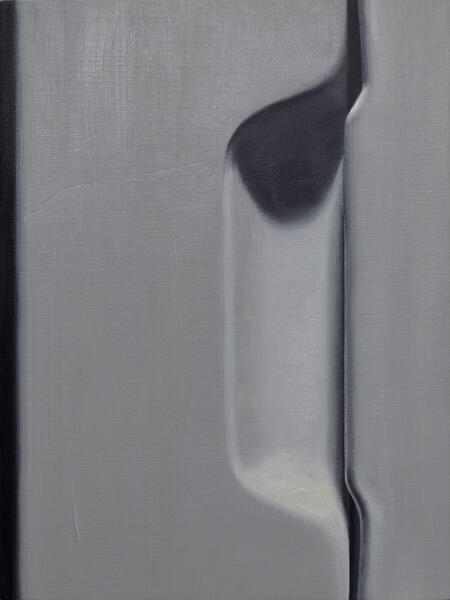 untitled (washer)16" x 12" 2013 Oil on Panel
untitled (washer)16" x 12" 2013 Oil on Panel -
 untitled (staple and tablecloth)16" x 20" 2013 Oil on Panel
untitled (staple and tablecloth)16" x 20" 2013 Oil on Panel -
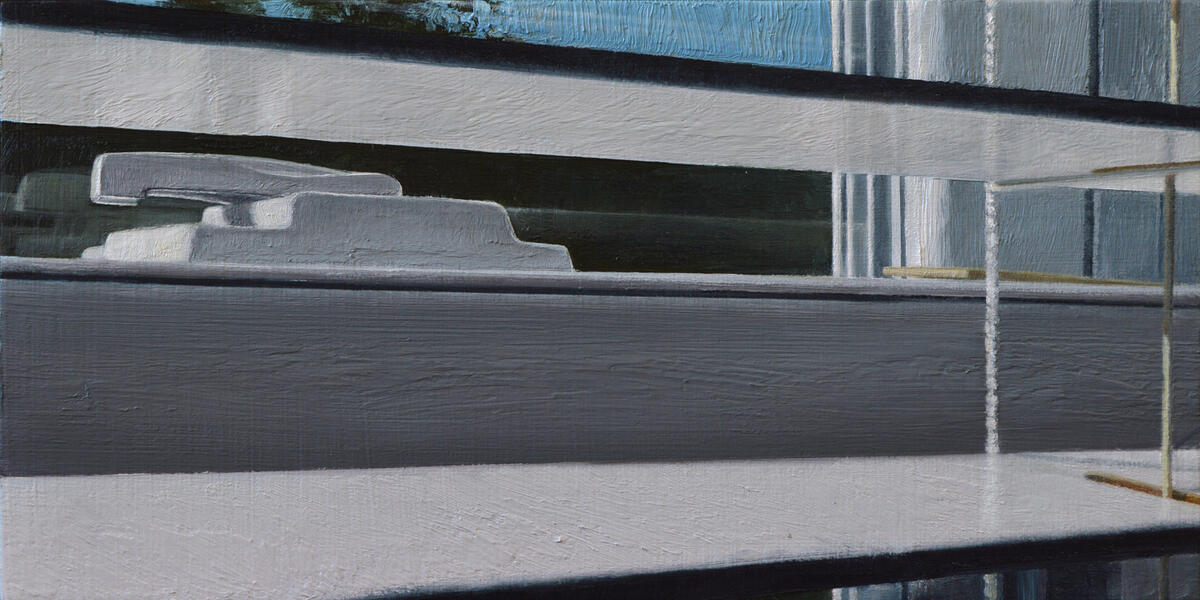 untitled (window latch)6" x 12" 2013 Oil on Panel
untitled (window latch)6" x 12" 2013 Oil on Panel -
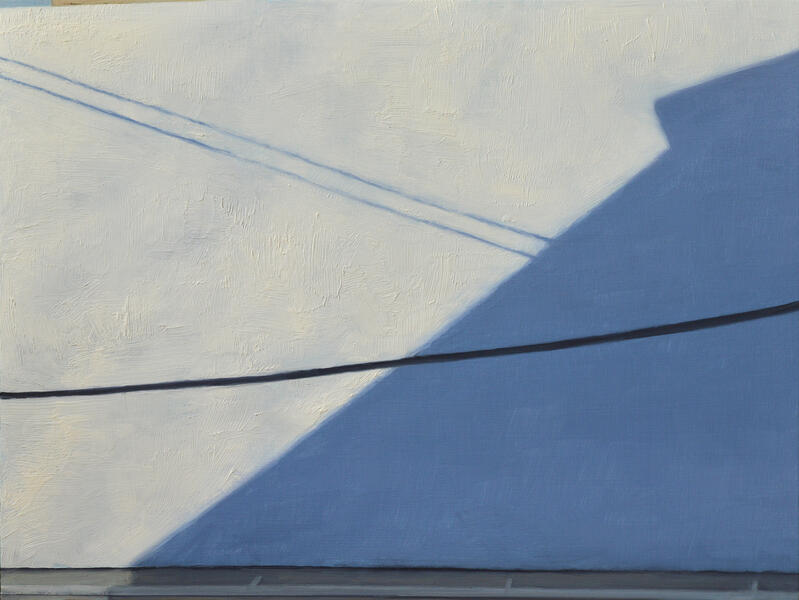 untitled (garage roof)18" x 24" 2013 Oil on Panel
untitled (garage roof)18" x 24" 2013 Oil on Panel -
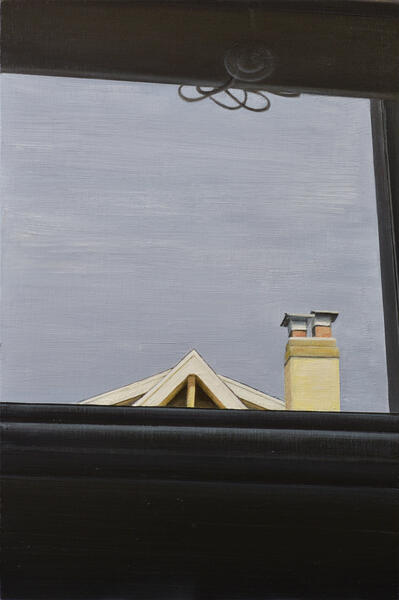 untitled (neighbors)18" x 12" 2013 Oil on Panel
untitled (neighbors)18" x 12" 2013 Oil on Panel
Sites of Power
"Sites of Power" explores structures in which power, an abstract concept, is embodied or performed. The paintings are based on my photographs of the scale models at Istanbul’s Miniaturk theme park. As imagery is translated from one medium to another, it becomes distorted: the “real” is processed and filtered, creating distance between the viewer and subject.
Painted with a clear reference to their photographic sources, but with severe cropping and awkward point-of-view, the images are reduced to formal composition, pattern and color, remaining only minimally recognizable. These quasi-abstract paintings thus return the reified concept of power to an abstract state, denuding the structures of the power they once wielded.
Further erosion occurs as moments of material imperfection are featured: cracks in plaster, Astroturf that curls up from its substrate, water stains on tarmac. In this way, an element of human frailty and disintegration is apparent in the otherwise idyllic model. The grand structures with which humans proclaim their power, wealth, status, and knowledge are not merely places: their influence and control over human behavior are performative exercises of power. When the building blocks are viewed up close, however, the intimidation upon which this control is based begins to break down.
This series attempts to further dismantle the mythology of such sites by disregarding the actual grand buildings as source material: the paintings instead reference photographs of their scale models. In presenting a miniature facsimile, models tame and disarm the mighty. When these tamed structures are subsequently photographed, they become souvenirs that literally fit in one’s pocket, or in the palm of one’s hand. This reference is significant and, consequently, the paintings preserve photographic details such as shallow depth of field and bokeh produced by the camera lens.
Painted with a clear reference to their photographic sources, but with severe cropping and awkward point-of-view, the images are reduced to formal composition, pattern and color, remaining only minimally recognizable. These quasi-abstract paintings thus return the reified concept of power to an abstract state, denuding the structures of the power they once wielded.
Further erosion occurs as moments of material imperfection are featured: cracks in plaster, Astroturf that curls up from its substrate, water stains on tarmac. In this way, an element of human frailty and disintegration is apparent in the otherwise idyllic model. The grand structures with which humans proclaim their power, wealth, status, and knowledge are not merely places: their influence and control over human behavior are performative exercises of power. When the building blocks are viewed up close, however, the intimidation upon which this control is based begins to break down.
This series attempts to further dismantle the mythology of such sites by disregarding the actual grand buildings as source material: the paintings instead reference photographs of their scale models. In presenting a miniature facsimile, models tame and disarm the mighty. When these tamed structures are subsequently photographed, they become souvenirs that literally fit in one’s pocket, or in the palm of one’s hand. This reference is significant and, consequently, the paintings preserve photographic details such as shallow depth of field and bokeh produced by the camera lens.
-
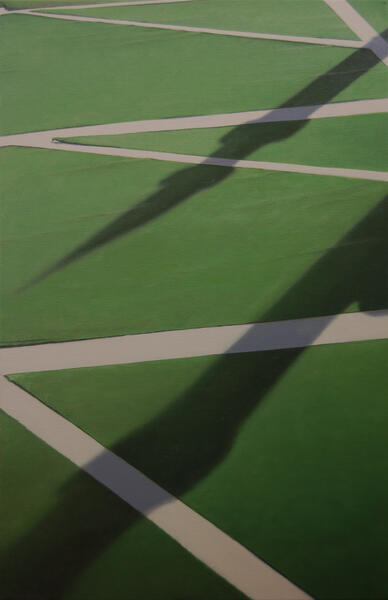 Suleymania34" x 22" 2011 Oil on Canvas
Suleymania34" x 22" 2011 Oil on Canvas -
 Hagia Sofia32" x 32" 2011 Oil on Canvas
Hagia Sofia32" x 32" 2011 Oil on Canvas -
 Haydarpasha Station24" x 36" 2011 Oil on Canvas
Haydarpasha Station24" x 36" 2011 Oil on Canvas -
 Temple of Artemis32" x 29" 2011 Oil on Canvas
Temple of Artemis32" x 29" 2011 Oil on Canvas -
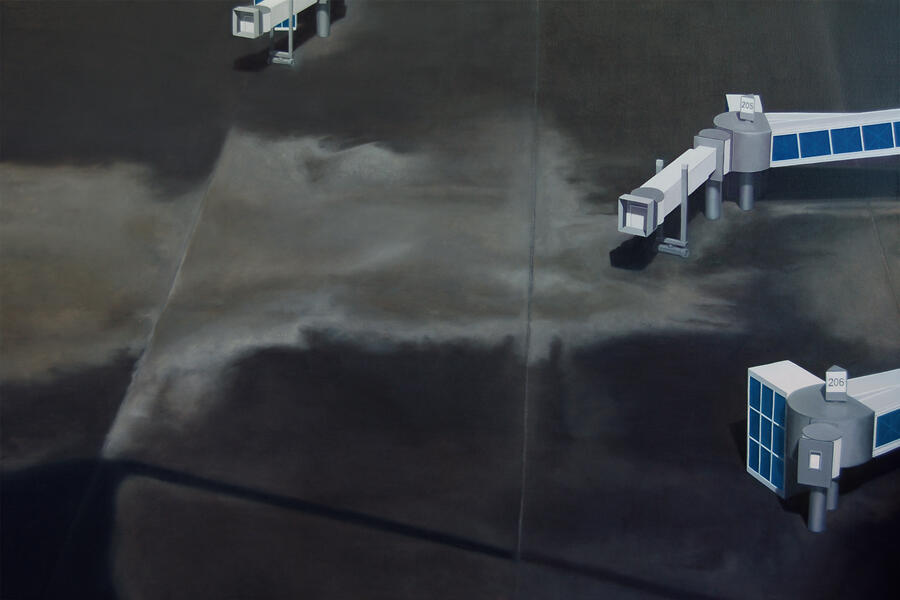 Ataturk Airport36" x 54" 2010 oil on canvas
Ataturk Airport36" x 54" 2010 oil on canvas -
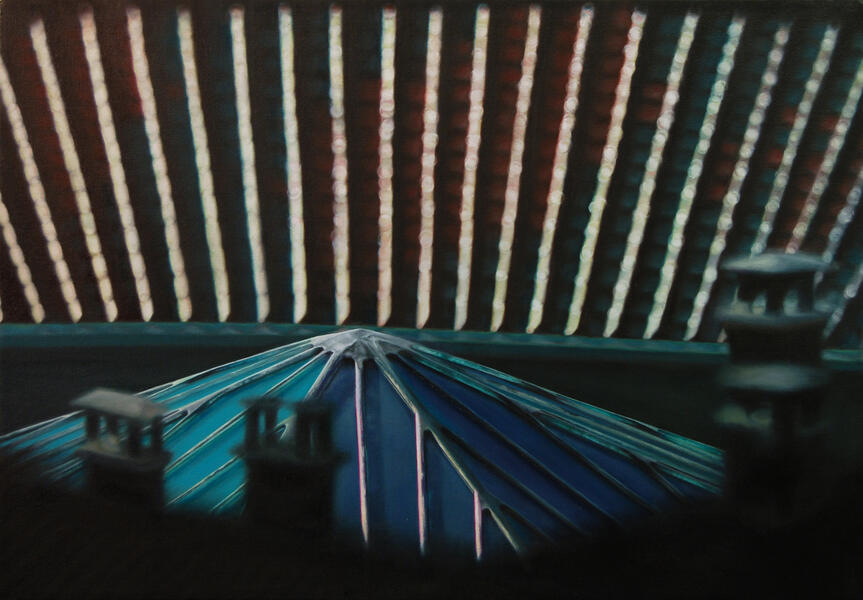 Khedive's Villa18" x 26 2010 oil on canvas
Khedive's Villa18" x 26 2010 oil on canvas -
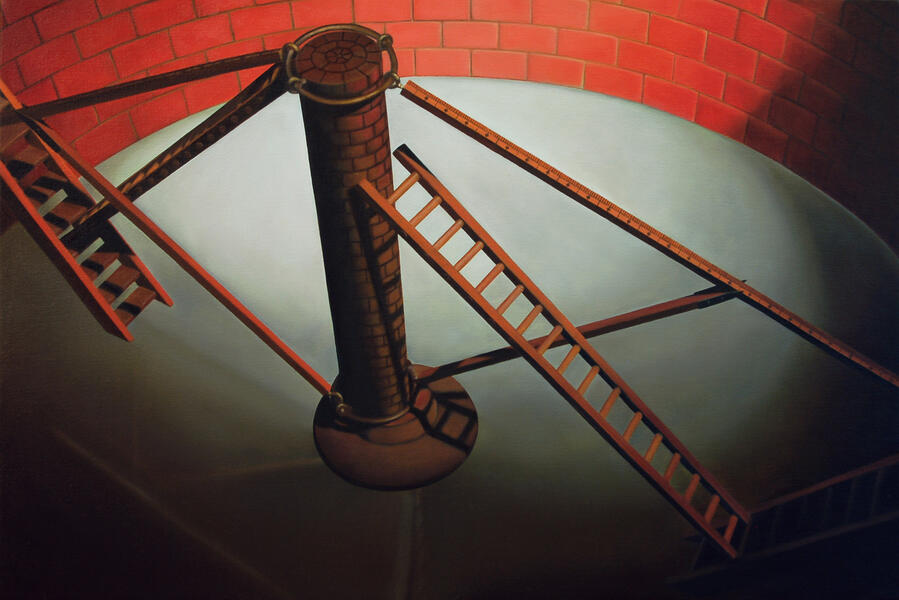 Observatory20" x 30" 2010 oil on canvas
Observatory20" x 30" 2010 oil on canvas -
 Gates24" x 36" 2011 Oil on Canvas
Gates24" x 36" 2011 Oil on Canvas -
 Railing32" x 32" 2011 Oil on Canvas
Railing32" x 32" 2011 Oil on Canvas -
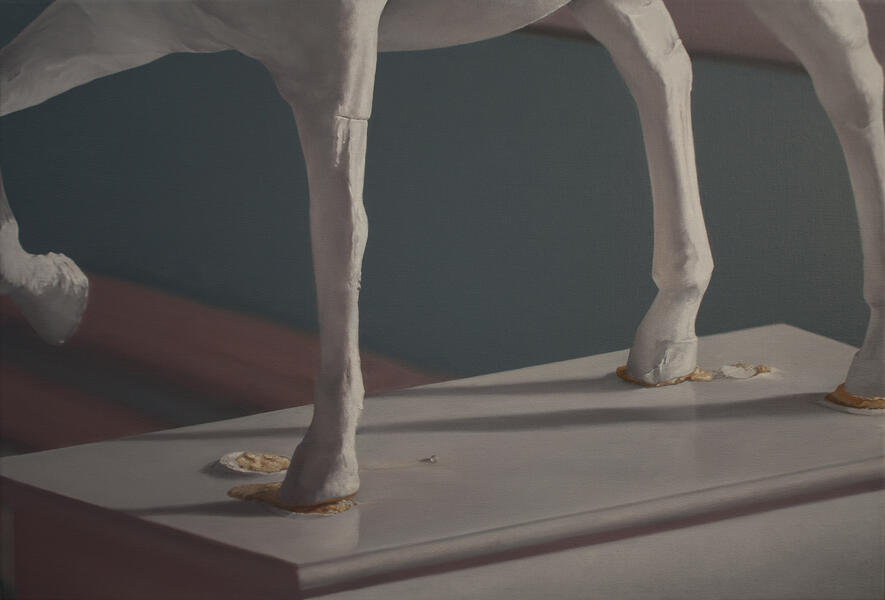 Halicarnassus I24" x 35" 2012 Oil on Canvas
Halicarnassus I24" x 35" 2012 Oil on Canvas


